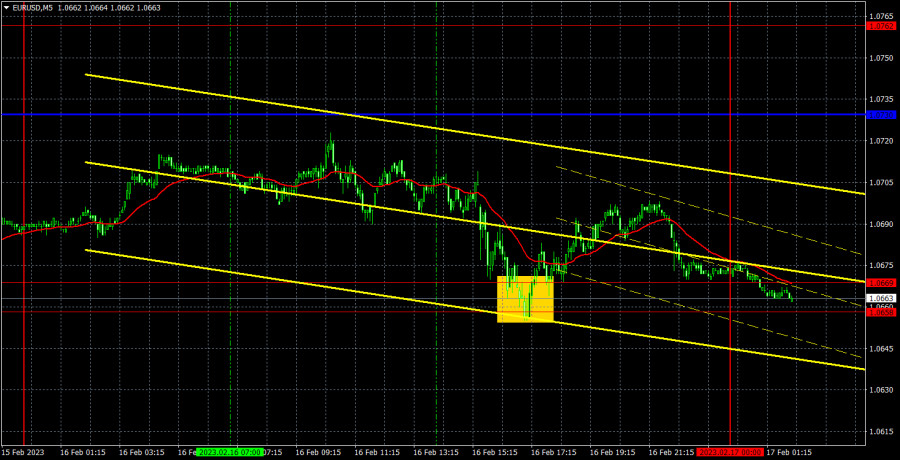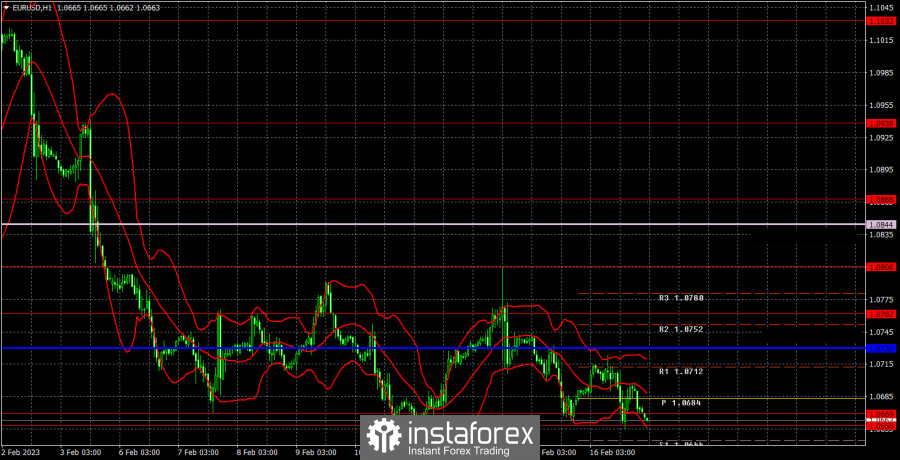

The EUR/USD currency pair dropped below the local "bottom" of 1.0658-1.0669 on the fourth trading day of the week for the third time. There were no legitimate reasons for the euro's decline today, but at the same time, the pair's overall movement was so weak throughout the day that it is impossible to characterize the decline as such. It was merely market noise, and there is no basis for it. There is no explanation because neither macroeconomic statistics nor the underlying backdrop exists today. The publication of several secondary reports in the United States did not affect the pair's movements. Only the producer price index may be mentioned, which unexpectedly rose by 0.7% every month but fell to 6% on an annual basis. For the US dollar, though, this is neither good nor bad.
The fact that no trading signals developed during the day is not surprising given that the pair remained stable for the majority of the day. In more specific terms, one did still form (recovery from the 1.0658–1.0669 area), but it did so too late. Even though traders tried to figure it out, it ended up being profitable. Since the price is below the Ichimoku indicator's lines, we anticipate that it will go past the area shown above. We think that the euro currency's decline is still ongoing; the market has merely been pausing for a while.The recent COT reports on the euro currency are entirely consistent with market activity. The aforementioned image makes it very evident that from the start of September, the net position of significant players (the second indicator) has been improving. At about the same time, the value of the euro started to increase. Although the net position of non-commercial traders is currently "bullish" and growing virtually weekly, it is the relatively high value of the "net position" that now permits the upward trend's impending end. The first indicator, which frequently occurs before the trend's end and shows that the red and green lines are very far apart from one another, signals this. The number of buy contracts from the "Non-commercial" group increased by 9.5 thousand during the most recent reporting week, while the number of short positions decreased by 2,000. The net position consequently increased by 7.5 thousand contracts. For non-commercial traders, there are currently 134 thousand more buy contracts than sell contracts. It is now unclear why there haven't been any new COT reports released in the last two weeks. As a result, we are currently limited by the data we have available. Nonetheless, the correction has been developing for a while, so it is obvious even without news that the pair should keep falling.
EUR/USD 1H analysis
The pair is still trending downward on the hourly timeframe and is once again trading below the crucial line. As a result, there is a flat between the levels of 1.0669 and 1.0806 and a downward trend on the one hand. Given that yesterday was the third time the lower border of the side channel rebounded, today will probably see another attempt to increase by 100 points. We reserve the following levels for trading on Friday: 1.0485, 1.0581, 1.0658–1.0669, 1.0762, 1.0806–1.0868, and 1.0938. We also reserve the Senkou Span B (1.0844) and Kijun-sen (1.0730) lines for use as support and resistance. The Ichimoku indicator's lines might move during the day, therefore this should be considered while choosing trade signals. Other support and resistance levels exist as well, but no signals are created close to them. Signals might be "bounces" and "overcoming" levels — extremes and lines. Remember to place a stop-loss order at breakeven if the price moves up or down by 15 points. If the signal turns out to be false, this will protect against potential losses. There are no notable events or publications scheduled for February 17 in either the European Union or the United States. As a result, traders won't have anything to react to during the day, allowing the pair to move in either way. Yet volatility is probably going to be low.
Explanations for the illustrations:
Thick red lines represent price levels of support and resistance (resistance/support), where the movement may come to an end. They don't provide trading signals, though.
The Ichimoku indicator's Kijun-sen and Senkou Span B lines have been moved from the 4-hour timeframe to the hourly one.
The price previously bounced off of the tiny red lines that represent extreme levels. They provide signals for trading.
Trend lines, trend channels, and other technical patterns are represented by yellow lines.
The net position size of each trading category is represented by indicator 1 on the COT charts.
The net position size for the "Non-commercial" category is shown by indicator 2 on the COT charts.